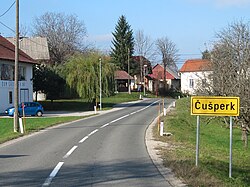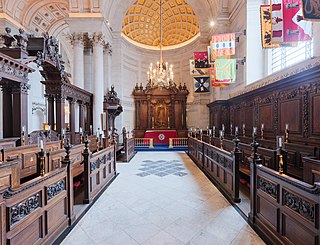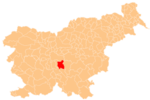
Grosuplje is a town in central Slovenia. It is the seat of the Municipality of Grosuplje. It lies just south of the capital Ljubljana in the traditional region of Lower Carniola. It is now included in the Central Slovenia Statistical Region.

Ivančna Gorica is a settlement and a municipality in central Slovenia. It is part of the traditional region of Lower Carniola and is now included in the Central Slovenia Statistical Region.

Ponoviče is a settlement along the left bank of the Sava River in the Municipality of Litija in central Slovenia. The railway line from Ljubljana to Zidani Most runs through the settlement. Traditionally the area was part of Styria and is now included with the rest of the municipality in the Central Sava Statistical Region. The settlement includes the hamlets of Mačkovina and Smrekarica.

Gombišče is a small settlement in the Municipality of Trebnje in eastern Slovenia. The area is part of the historical region of Lower Carniola. The municipality is now included in the Southeast Slovenia Statistical Region. It includes the hamlet of Vrh.
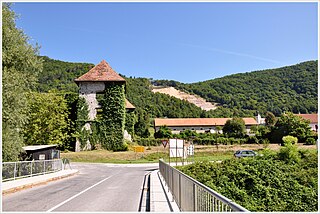
Soteska is a settlement on the left bank of the Krka River in the Municipality of Dolenjske Toplice in Slovenia. The area is part of the historical region of Lower Carniola. The municipality is now included in the Southeast Slovenia Statistical Region. Soteska includes the hamlet of Ključ southeast of the main settlement.

Starihov Vrh is a settlement south of Semič in southeastern Slovenia. The area is part of the historical region of Lower Carniola. The Municipality of Semič is now included in the Southeast Slovenia Statistical Region.

Mokronog is a settlement in the Municipality of Mokronog-Trebelno in southeastern Slovenia. It is also the administrative centre of the municipality. The area is part of the historical region of Lower Carniola. The municipality is now included in the Southeast Slovenia Statistical Region.

Dolenje Radulje is a village in the Municipality of Škocjan in southeastern Slovenia. Within the municipality, it belongs to the Local Community of Bučka. The area is part of the historical region of Lower Carniola. The municipality is now included in the Southeast Slovenia Statistical Region.
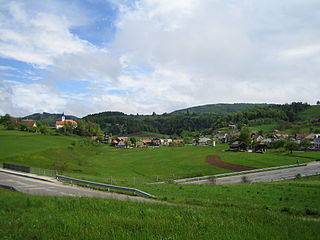
Polica is a settlement in the Municipality of Grosuplje in central Slovenia. The area is part of the historical region of Lower Carniola. The municipality is now included in the Central Slovenia Statistical Region. Polica includes the hamlets of Bliska Vas, Žabja Vas, Hrib, and Goričane.

Šmarje–Sap is a settlement in the Municipality of Grosuplje in central Slovenia. The area is part of the historical region of Lower Carniola. The municipality is now included in the Central Slovenia Statistical Region.

Žalna is a settlement in the Municipality of Grosuplje in central Slovenia. It lies southeast of Grosuplje in the historical region of Lower Carniola. The municipality is now included in the Central Slovenia Statistical Region. It includes the hamlets of Prevale, Velika Žalna, and Mala Žalna, as well as part of the hamlet of Na Šoli.
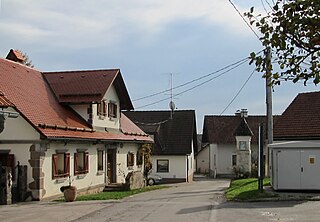
Zgornja Slivnica is a settlement in the Municipality of Grosuplje in central Slovenia. It lies in the hills north of Grosuplje and northeast of Šmarje-Sap and south of Mali Lipoglav in the historical region of Lower Carniola. The municipality is now included in the Central Slovenia Statistical Region.

Vino is a small village in the Municipality of Grosuplje in central Slovenia. It lies in the hills west of Grosuplje in the historical region of Lower Carniola. The municipality is now included in the Central Slovenia Statistical Region.

Veliko Mlačevo is a village in the Municipality of Grosuplje in central Slovenia. It lies just southeast of Grosuplje itself in the historical region of Lower Carniola. The municipality is now included in the Central Slovenia Statistical Region. The settlement includes the hamlet of Boštanj south of the main settlement.

Mali Konec is a small settlement in the hills north of Polica in the Municipality of Grosuplje in central Slovenia. The area is part of the historical region of Lower Carniola. The municipality is now included in the Central Slovenia Statistical Region.
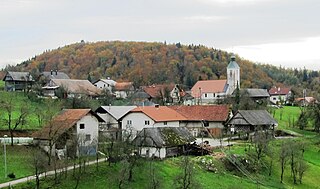
Troščine is a small village north of Polica in the Municipality of Grosuplje in central Slovenia. The area is part of the historical region of Lower Carniola. The municipality is now included in the Central Slovenia Statistical Region.

Velika Račna is a village in the Municipality of Grosuplje in central Slovenia. The area is part of the historical region of Lower Carniola. The municipality is now included in the Central Slovenia Statistical Region. Kopanj Hill rises 70 m above the village to the north; geologically, the hill is a mix of karst limestone and dolomite. The hamlet of Kopanj is located on Kopanj Hill.
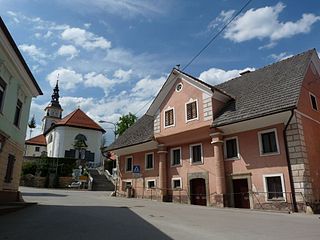
Šentvid pri Stični is a settlement in the Municipality of Ivančna Gorica in central Slovenia. The area is part of the historical region of Lower Carniola. The municipality is now included in the Central Slovenia Statistical Region. In addition to the sections of the main settlement known as Stari Trg and Zadolžna Vas, it includes the hamlets of Travnik, Sveti Rok, Omotce, Postaja Šentvid, and Marof.

Gabrje pri Stični is a settlement just north of Stična in the Municipality of Ivančna Gorica in central Slovenia. The area is part of the historical region of Lower Carniola. The municipality is now included in the Central Slovenia Statistical Region. The settlement includes the hamlets of Kurja Vas, Potok, Pungrt, and Nograd.

Črni Potok is a dispersed settlement in the valley of Black Creek south of Šmartno pri Litiji in central Slovenia. The area is part of the historical region of Lower Carniola. The entire Municipality of Šmartno pri Litiji is now included in the Central Slovenia Statistical Region. It includes the hamlets of Brezje and Sela.
